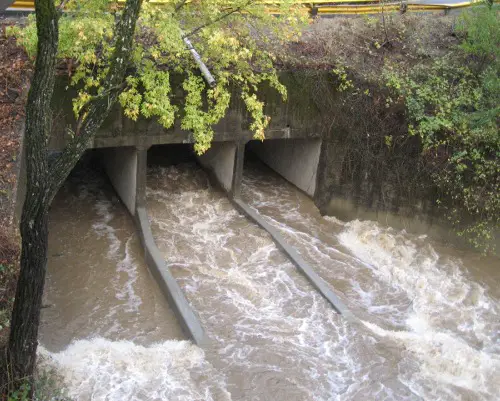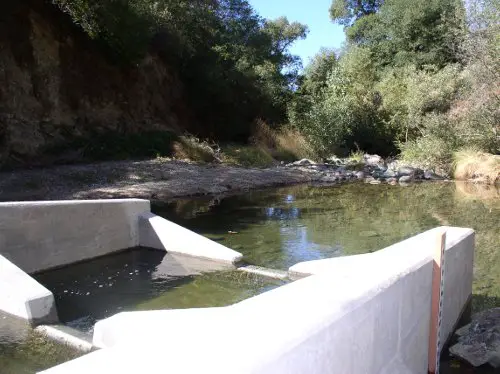
MIDDLETOWN – Earth-friendly technologies and sustainable ways of supporting energy and business were a theme in Lake County on Thursday.
In the morning, Congressman Mike Thompson was on hand for the dedication of the county's solar array near Lakeport. Then, on Thursday afternoon, he made the trip to the Calpine Visitors Center, where he was honored by Calpine, which named a new fish ladder on Big Sulfur Creek in his honor.
Supervisors Jim Comstock and Jeff Smith, as well as state and federal officials, were on hand for the presentation at the Calpine Visitors Center.
The Big Sulfur Creek fish passage project is a joint project between Calpine, the National Oceanic and Atmospheric Administration's (NOAA) National Marine Fisheries Service and the California Department of Fish and Game.
Completed last October, the fish ladder was shaped to create stable streaming flow conditions along its margins at moderate to high water levels. It includes ladder steps designed to provide juvenile fish passage at lower flows, and allows upstream fish migration over a wider range of stream flows compared to traditional fish ladders.
Calpine spent six years working on the project, beginning in 2001, said Calpine Senior Vice President Mike Rogers.
“This really is an exceptional example of sustainability,” said Rogers, who added that it's an example of industry and government coming together on an important project.
The company had been meeting with officials from state Fish and Game when the subject of Russian River steelhead came up, Rogers said. The fish were having trouble migrating through a part of the river.
Specifically, a road crossing on The Geysers property, consisting of a triple concrete box culvert, was found to be a partial barrier to fish migrating upstream, according to a Calpine report.
So began what would be years of what Rogers called “formidable tasks” – from studying the stream to designing a project, getting complex permits and diverting the stretch of river while the fish ladder was constructed, said Rogers.
The end result was unobstructed, year-around access to the largest suitable spawning and rearing habitat on Big Sulfur Creek – one of the largest tributaries to the Russian River – above the confluence with Squaw Creek, according to Calpine.
Officials explained that steelhead trout spawn from December through April in coarse gravel areas of small streams and tributaries where cool, well-oxygenated water is available year-round.
David White of NOAA explained that the steelhead is a threatened species, and Big Sulfur Creek is a unique habitat. The fish ladder maximizes the amount of habitat available in the river, he said.
To underline the project's importance, White explained that the Russian River's steelhead runs were estimated to have 65,000 fish in the 1970s. In recent years, that number has plummeted to between 3,000 and 6,000 steelhead.
The reduction in habitat and dewatering of stream tributaries were devastating the steelhead population, White said.
But there's hope that the steelhead – which is very sensitive to environmental conditions – will come back. White said two adult steelhead were found at the project site, along with close to 2,400 juveniles. They also found 1,000 yellow-legged frog tadpoles, two California giant salamanders and about 1,000 red-legged salamander larvae.
The creek is home to a very rich assembly of California native fishes, said White.
Rogers paid tribute to Thompson, who was on the short list of candidates considered to lead the federal Department of the Interior.
Thompson lauded the work of the NOAA scientists, who he said are doing good scientific work for the government.
He said fish are an environmental canary in the mine shaft.
“If the fish aren't living where they're supposed to be living, something is wrong,” said Thompson.
Thompson recalled that he and Calpine go back a long way.
While he was in the state Legislature in the 1990s, the effort got under way to put in place Lake County's effluent pipeline to The Geysers – where the treated wastewater is injected into the steamfields to help generate geothermal power.
Thompson was elected to Congress in 1998 and when he got to Washington, DC, he started working on the pipeline issue. It was placed in a bill but the Army Corps of Engineers said it would not allow the project even if the bill was approved.
“I was up against the wall,” said Thompson.
He said he received a call from a White House staffer asking if he was still going to support the bill in which the pipeline was included, and Thompson said no.
A short time later he got a call from the President Bill Clinton asking why he was changing his vote.
Thompson said he told Clinton about Lake County's pipeline and the problems he was having with the Army Corps of Engineers.
“It is so, so wonderful when you're needed,” said Thompson, recalling how the problem was suddenly solved and the pipeline was allowed to go forward.
“Renewable energy is so important to us and our future,” Thompson said.
He said he hopes to see the steelhead numbers recover after a 90-percent drop in fish numbers since the 1960s.
For the First Congressional District, steelhead and salmon are a big part of the economy, heritage and culture, Thompson said.
A trip had been planned to go to the fish ladder, but Calpine officials said concerns about a rock slide on the road preempted the trip. Instead, visitors were taken up to see The Geysers site.
E-mail Elizabeth Larson at This email address is being protected from spambots. You need JavaScript enabled to view it..


{mos_sb_discuss:3}